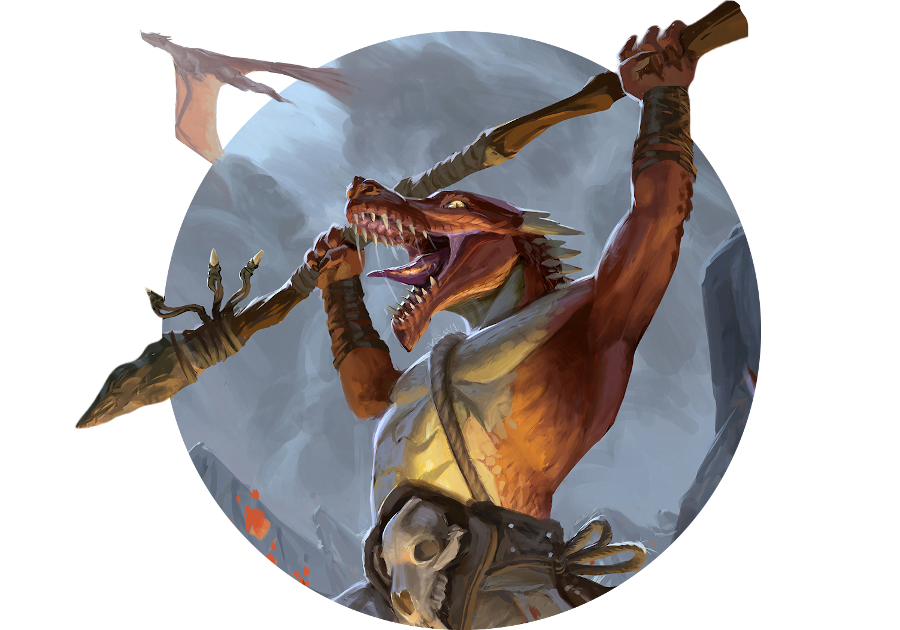I’ve spoken about the role of the Goblin on Cobrin’Seil, but what about the kobold? I did bring up the question of hey why are these two so alike? And the followup question of where do they come from? The answer to both is ‘authors are weird,’ but I’m looking at it more in terms of how I can build and shape the world I’m putting players into, and I want the kobolds there to be both interesting enough as a player option without depriving people of the opportunity to use easy content where kobolds are happy to try and stick spears in players.
I am a fan of thinking about cultures in terms of their places in the world. That often requires answering the question ‘why are they here?’
Why then, are kobolds here?

Okay, though, first I want to talk to you about convergent design. This happens in a lot of crafts all over the world, where people who can make tools, in some form or another, eventually develop a way to make tools that address the same problem and usually develop the same tools if they’re universally applicable enough. An example would be knives. Cultures work out the design of what you consider ‘a knife’ pretty quickly, and that design then gets explored in its individual space; the Indian Kukri is designed for different jobs to the Nori knife of Japan is designed for different jobs for the Machete of Brazil, but they are all recognisably knives and probably all got started with the job of ‘I need something I can hold in my hand to cut things.’
There are a lot more specific individual forms of convergent design. Almost every programmer I know has re-made some tool that other people have made, because even if the tool is useful for the general, the specifics of what that design needs works for their needs. These are often extremely bodgy — coders doing fun things like making a program with no documentation/output/messages just to do a thing invisibly because that’s how they want it to work for their use case, even if they’d never release software that’s meant to do that for other programmers.
Hypothetically, this metaphor can expand, with ideas like open source, but it’s rare for programmers to put their genuinely garbage code out there on the internet for other people to use, and it’s even more rare for that garbage code to get looked at. The two problems of the internet: being seen and not being seen.
Alright? Convergent design, tool using people making things, things being defined by the problem they were made to solve, releasing it out into a shared space for development.
And I need you to think about these things when I’m talking about kobolds.

Dragons are our coders in this situation. Dragons are big and powerful and operate like functional governments. Governments make things to serve their needs. At some point, in the past, a dragon needed something done, and they made a tool to do it. Then they needed something else done and made another tool. Then, eventually, they had enough small tasks they needed doing in a reasonably automated period, that a dragon invented a useful tool that managed and maintained itself. That was the first kobold.
The question, though, of ‘who made the first kobold’ is a problem because every dragon over a certain age, before kobolds were a known thing, made something more or less like a kobold. Some made things like sentient pillars of stone or elaborate computer systems, but those systems didn’t do a good job of perpetuating themselves and eventually, they made something like a kobold.
Kobolds are useful, flexible, and if they can’t solve a problem right now, they can be set to the task and eventually solve it. They can do processes while you’re sleeping, they don’t pose a threat to you personally, and they’re functionally ‘cheap and easy’ to produce more of. That means that there are a lot of dragons that at some point, may have thought they made ‘the first kobold’ only to find that someone else made something more or less the same a bit earlier.
This didn’t mean those first kobolds were identical. They were similar, though. They were similar enough that when they came into contact with one another for the first time, though, they could tell that they were ‘more or less’ the same thing. And this is the point where the dragons’ control over their own little closed ecosystems of kobold tools broke. Kobolds started sharing stories and culture and all that. Traits from one kobold design over here are showing up over there, and suddenly this culture that started out as magically-crafted tools for a specific purpose without much forethought to quality control are a group of people with shared culture and stories and yes, even a culture-wide deference to Dragons and love of solving problems and crafting traps.
No dragon is too sure which dragon made the first kobold, and while many of the oldest dragons are convinced that they know (or that they did), there’s no proof one way or another.

Here’s the other thing, an old idea from old Cobrin’Seil to the newer way of it being. Back in 3.5 D&D, kobolds weren’t a player option. They were a monster that players could play, if they wanted to, but there wasn’t (at first) any reason to, because they were so catastrophically weak. They were small, and had a -4 strength penalty, meaning that typical kobold NPCs dealt with spears something like 1-4 points of damage, and statistically were most likely to deal 1.
I didn’t like that, and I had a slightly tweaked version for my home games, and my own kobold lore. The idea was that kobolds got access to ‘god killer metal’ and made an elaborate machine with it which they used to assassinate their corrupt and cruel god Kurtulmak. There was a really intense narrative I wove there about trying to resist a truly totalitarian state that could live in your head, about what destroying theocracy would do to your brain, and how you would be damaged by the experience at the end.
I was putting a lot of myself in that story, in hindsight.
Now, however, I don’t need that angle, because I don’t have the idea that kobolds and their god are inherently intertwined. Kurtulmak may be a kobold god, that many kobolds revere, but odds are good kurtulmak doesn’t want to tussle too openly with some of the really scary dragons out there. Instead, what we have here are a bunch of kobolds that probably, at some point, pushed far enough by the worst dragons, icked them. There’s still the same history of overthrowing (some) tyrants and collaborating with (some) tyrants, but it’s not all one single within-our-lifetimes event.
That’s the gap between them. Goblins evolved to cohabitate with whoever they could. Kobolds were made, then claimed their own destiny. Similar roles, similar presences, but if you asked them to talk about their worldviews, your typical kobold and typical goblin wouldn’t have much meaningful overlap at all.